Swinburne University MKT20019 Research Brief: Ladder Art Space
VerifiedAdded on 2021/01/05
|6
|1905
|443
Report
AI Summary
This research brief, prepared for Swinburne University's MKT20019 course, addresses the marketing challenges faced by Ladder Art Space (LAS). The report begins with an executive summary outlining LAS's current situation, including its offerings of workshops and art classes. The internal situation highlights the need to increase profit margins, expand clientele, and attract younger male participants. The external situation considers the broader context of arts education and gender perceptions in visual arts. The core of the brief defines the marketing problem: low male participation, particularly among 18-30 year olds. The research problem is to investigate attitudes and perceptions, and gender differences, towards visual arts. Three research objectives are established to comprehend attitudes, determine factors affecting participation, and identify gender influences. The brief outlines specific research questions for each objective, covering topics such as male and female attitudes, the impact of other interests, and influences on participation rates. A timescale of four weeks and a budget funded by Swinburne University are specified. References to supporting literature are included, providing a basis for further research and analysis of the marketing problem.

Swinburne University of Technology – Alexandra Gayfer – 102292401
2020 –HS1 – MKT20019
Assessment ONE – Research Brief – Ladder Art Space
5th of April 11:59 – 1,500
Research Brief
Ladder Art Space
2020
[Type text] [Type text] [Type text]1
2020 –HS1 – MKT20019
Assessment ONE – Research Brief – Ladder Art Space
5th of April 11:59 – 1,500
Research Brief
Ladder Art Space
2020
[Type text] [Type text] [Type text]1
Paraphrase This Document
Need a fresh take? Get an instant paraphrase of this document with our AI Paraphraser
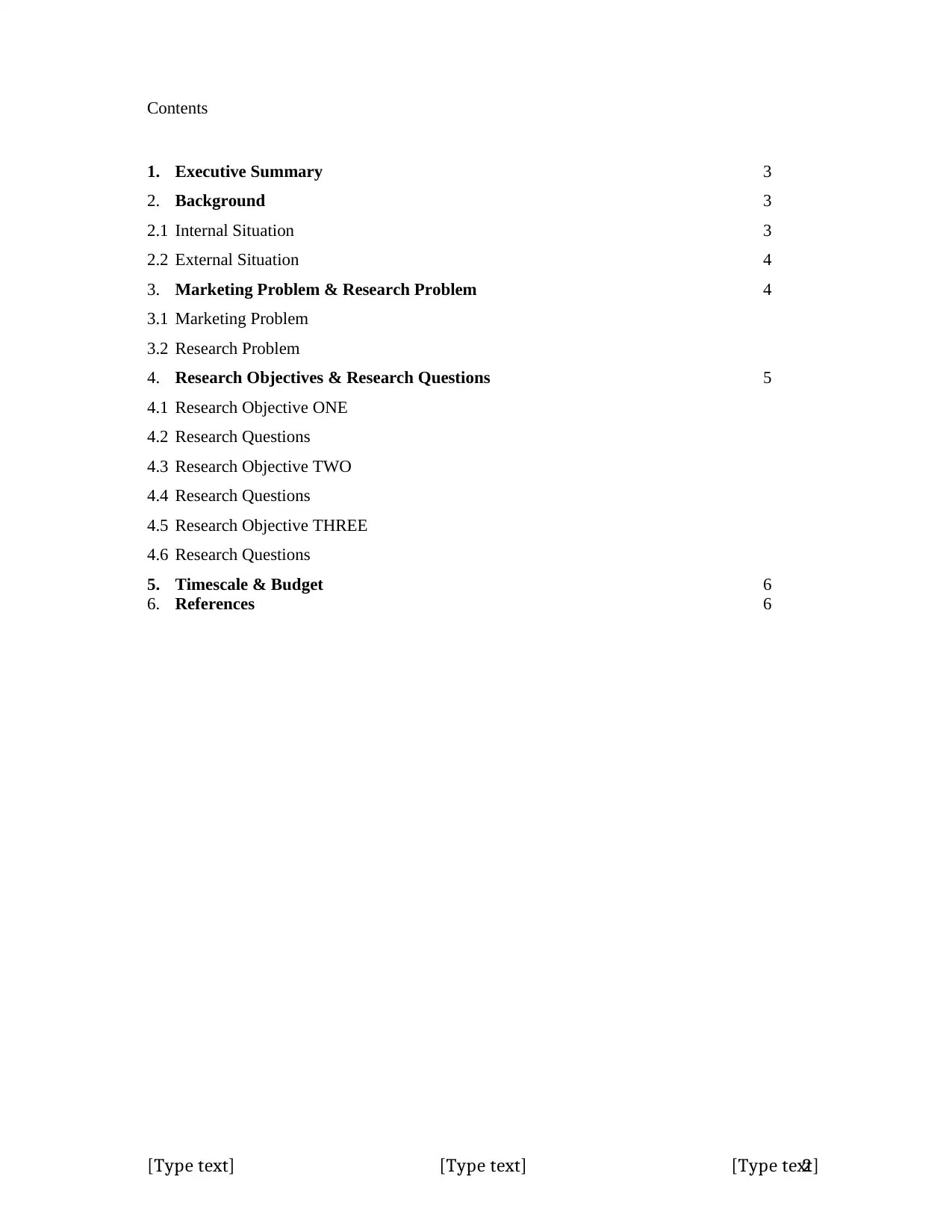
Contents
1. Executive Summary 3
2. Background 3
2.1 Internal Situation 3
2.2 External Situation 4
3. Marketing Problem & Research Problem 4
3.1 Marketing Problem
3.2 Research Problem
4. Research Objectives & Research Questions 5
4.1 Research Objective ONE
4.2 Research Questions
4.3 Research Objective TWO
4.4 Research Questions
4.5 Research Objective THREE
4.6 Research Questions
5. Timescale & Budget 6
6. References 6
[Type text] [Type text] [Type text]2
1. Executive Summary 3
2. Background 3
2.1 Internal Situation 3
2.2 External Situation 4
3. Marketing Problem & Research Problem 4
3.1 Marketing Problem
3.2 Research Problem
4. Research Objectives & Research Questions 5
4.1 Research Objective ONE
4.2 Research Questions
4.3 Research Objective TWO
4.4 Research Questions
4.5 Research Objective THREE
4.6 Research Questions
5. Timescale & Budget 6
6. References 6
[Type text] [Type text] [Type text]2
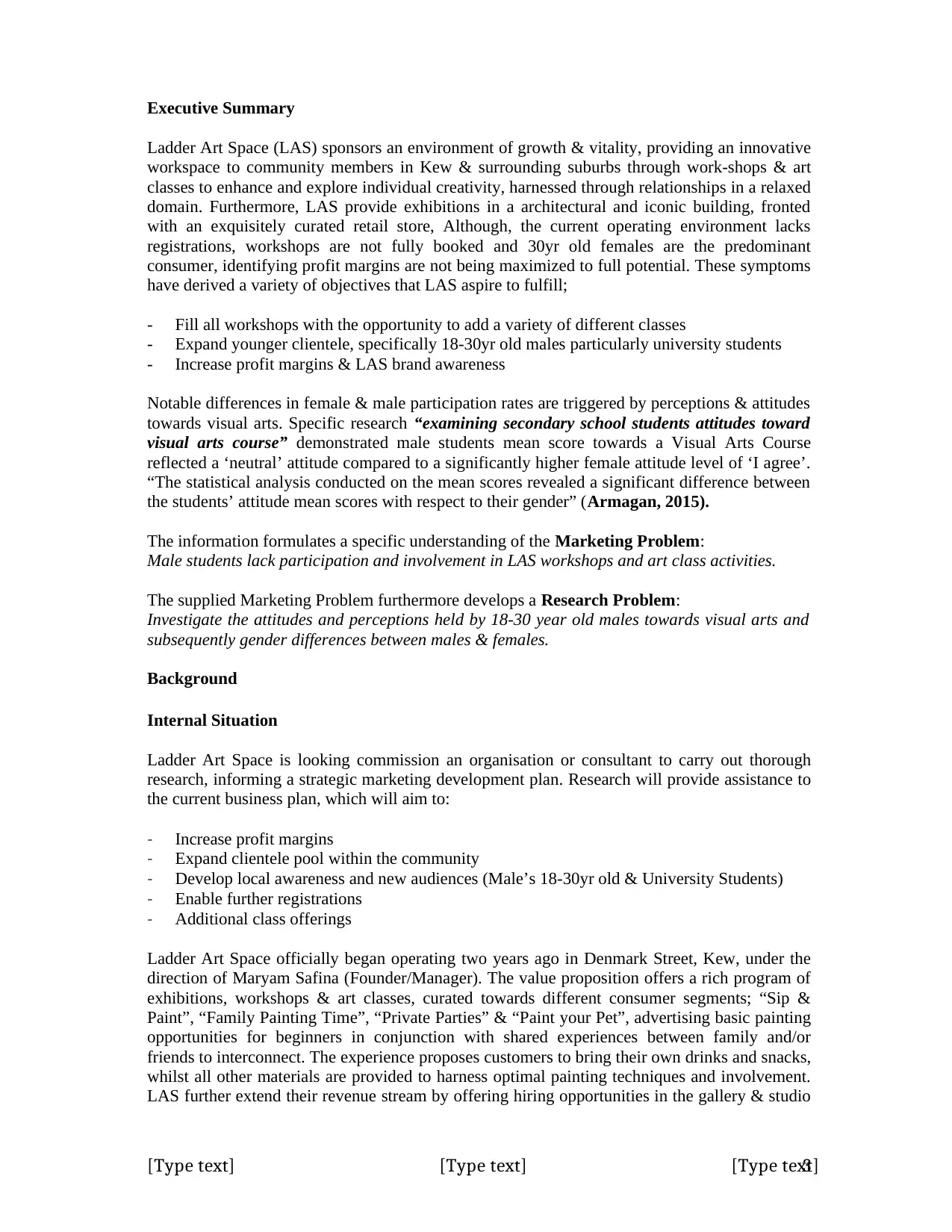
Executive Summary
Ladder Art Space (LAS) sponsors an environment of growth & vitality, providing an innovative
workspace to community members in Kew & surrounding suburbs through work-shops & art
classes to enhance and explore individual creativity, harnessed through relationships in a relaxed
domain. Furthermore, LAS provide exhibitions in a architectural and iconic building, fronted
with an exquisitely curated retail store, Although, the current operating environment lacks
registrations, workshops are not fully booked and 30yr old females are the predominant
consumer, identifying profit margins are not being maximized to full potential. These symptoms
have derived a variety of objectives that LAS aspire to fulfill;
- Fill all workshops with the opportunity to add a variety of different classes
- Expand younger clientele, specifically 18-30yr old males particularly university students
- Increase profit margins & LAS brand awareness
Notable differences in female & male participation rates are triggered by perceptions & attitudes
towards visual arts. Specific research “examining secondary school students attitudes toward
visual arts course” demonstrated male students mean score towards a Visual Arts Course
reflected a ‘neutral’ attitude compared to a significantly higher female attitude level of ‘I agree’.
“The statistical analysis conducted on the mean scores revealed a significant difference between
the students’ attitude mean scores with respect to their gender” (Armagan, 2015).
The information formulates a specific understanding of the Marketing Problem:
Male students lack participation and involvement in LAS workshops and art class activities.
The supplied Marketing Problem furthermore develops a Research Problem:
Investigate the attitudes and perceptions held by 18-30 year old males towards visual arts and
subsequently gender differences between males & females.
Background
Internal Situation
Ladder Art Space is looking commission an organisation or consultant to carry out thorough
research, informing a strategic marketing development plan. Research will provide assistance to
the current business plan, which will aim to:
- Increase profit margins
- Expand clientele pool within the community
- Develop local awareness and new audiences (Male’s 18-30yr old & University Students)
- Enable further registrations
- Additional class offerings
Ladder Art Space officially began operating two years ago in Denmark Street, Kew, under the
direction of Maryam Safina (Founder/Manager). The value proposition offers a rich program of
exhibitions, workshops & art classes, curated towards different consumer segments; “Sip &
Paint”, “Family Painting Time”, “Private Parties” & “Paint your Pet”, advertising basic painting
opportunities for beginners in conjunction with shared experiences between family and/or
friends to interconnect. The experience proposes customers to bring their own drinks and snacks,
whilst all other materials are provided to harness optimal painting techniques and involvement.
LAS further extend their revenue stream by offering hiring opportunities in the gallery & studio
[Type text] [Type text] [Type text]3
Ladder Art Space (LAS) sponsors an environment of growth & vitality, providing an innovative
workspace to community members in Kew & surrounding suburbs through work-shops & art
classes to enhance and explore individual creativity, harnessed through relationships in a relaxed
domain. Furthermore, LAS provide exhibitions in a architectural and iconic building, fronted
with an exquisitely curated retail store, Although, the current operating environment lacks
registrations, workshops are not fully booked and 30yr old females are the predominant
consumer, identifying profit margins are not being maximized to full potential. These symptoms
have derived a variety of objectives that LAS aspire to fulfill;
- Fill all workshops with the opportunity to add a variety of different classes
- Expand younger clientele, specifically 18-30yr old males particularly university students
- Increase profit margins & LAS brand awareness
Notable differences in female & male participation rates are triggered by perceptions & attitudes
towards visual arts. Specific research “examining secondary school students attitudes toward
visual arts course” demonstrated male students mean score towards a Visual Arts Course
reflected a ‘neutral’ attitude compared to a significantly higher female attitude level of ‘I agree’.
“The statistical analysis conducted on the mean scores revealed a significant difference between
the students’ attitude mean scores with respect to their gender” (Armagan, 2015).
The information formulates a specific understanding of the Marketing Problem:
Male students lack participation and involvement in LAS workshops and art class activities.
The supplied Marketing Problem furthermore develops a Research Problem:
Investigate the attitudes and perceptions held by 18-30 year old males towards visual arts and
subsequently gender differences between males & females.
Background
Internal Situation
Ladder Art Space is looking commission an organisation or consultant to carry out thorough
research, informing a strategic marketing development plan. Research will provide assistance to
the current business plan, which will aim to:
- Increase profit margins
- Expand clientele pool within the community
- Develop local awareness and new audiences (Male’s 18-30yr old & University Students)
- Enable further registrations
- Additional class offerings
Ladder Art Space officially began operating two years ago in Denmark Street, Kew, under the
direction of Maryam Safina (Founder/Manager). The value proposition offers a rich program of
exhibitions, workshops & art classes, curated towards different consumer segments; “Sip &
Paint”, “Family Painting Time”, “Private Parties” & “Paint your Pet”, advertising basic painting
opportunities for beginners in conjunction with shared experiences between family and/or
friends to interconnect. The experience proposes customers to bring their own drinks and snacks,
whilst all other materials are provided to harness optimal painting techniques and involvement.
LAS further extend their revenue stream by offering hiring opportunities in the gallery & studio
[Type text] [Type text] [Type text]3
⊘ This is a preview!⊘
Do you want full access?
Subscribe today to unlock all pages.

Trusted by 1+ million students worldwide
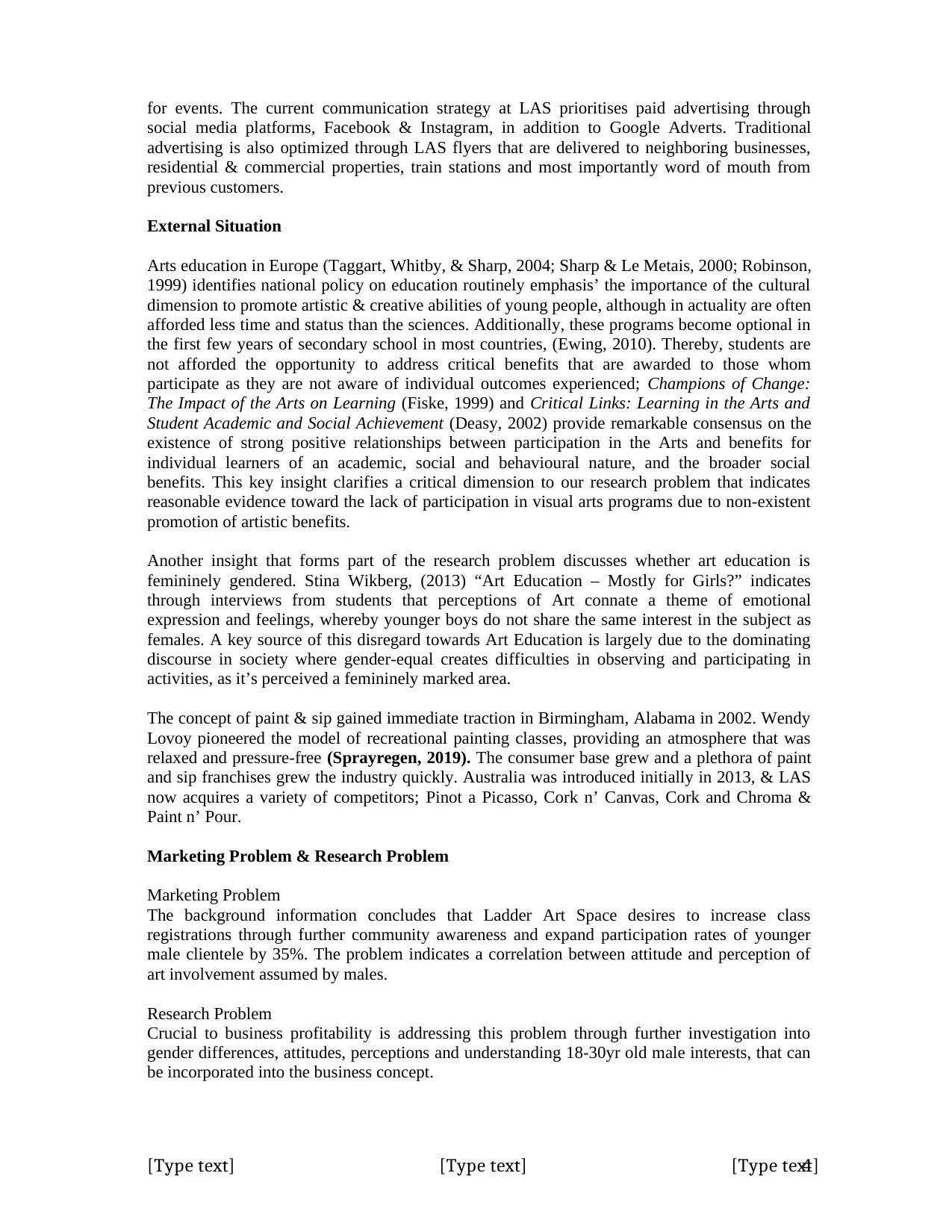
for events. The current communication strategy at LAS prioritises paid advertising through
social media platforms, Facebook & Instagram, in addition to Google Adverts. Traditional
advertising is also optimized through LAS flyers that are delivered to neighboring businesses,
residential & commercial properties, train stations and most importantly word of mouth from
previous customers.
External Situation
Arts education in Europe (Taggart, Whitby, & Sharp, 2004; Sharp & Le Metais, 2000; Robinson,
1999) identifies national policy on education routinely emphasis’ the importance of the cultural
dimension to promote artistic & creative abilities of young people, although in actuality are often
afforded less time and status than the sciences. Additionally, these programs become optional in
the first few years of secondary school in most countries, (Ewing, 2010). Thereby, students are
not afforded the opportunity to address critical benefits that are awarded to those whom
participate as they are not aware of individual outcomes experienced; Champions of Change:
The Impact of the Arts on Learning (Fiske, 1999) and Critical Links: Learning in the Arts and
Student Academic and Social Achievement (Deasy, 2002) provide remarkable consensus on the
existence of strong positive relationships between participation in the Arts and benefits for
individual learners of an academic, social and behavioural nature, and the broader social
benefits. This key insight clarifies a critical dimension to our research problem that indicates
reasonable evidence toward the lack of participation in visual arts programs due to non-existent
promotion of artistic benefits.
Another insight that forms part of the research problem discusses whether art education is
femininely gendered. Stina Wikberg, (2013) “Art Education – Mostly for Girls?” indicates
through interviews from students that perceptions of Art connate a theme of emotional
expression and feelings, whereby younger boys do not share the same interest in the subject as
females. A key source of this disregard towards Art Education is largely due to the dominating
discourse in society where gender-equal creates difficulties in observing and participating in
activities, as it’s perceived a femininely marked area.
The concept of paint & sip gained immediate traction in Birmingham, Alabama in 2002. Wendy
Lovoy pioneered the model of recreational painting classes, providing an atmosphere that was
relaxed and pressure-free (Sprayregen, 2019). The consumer base grew and a plethora of paint
and sip franchises grew the industry quickly. Australia was introduced initially in 2013, & LAS
now acquires a variety of competitors; Pinot a Picasso, Cork n’ Canvas, Cork and Chroma &
Paint n’ Pour.
Marketing Problem & Research Problem
Marketing Problem
The background information concludes that Ladder Art Space desires to increase class
registrations through further community awareness and expand participation rates of younger
male clientele by 35%. The problem indicates a correlation between attitude and perception of
art involvement assumed by males.
Research Problem
Crucial to business profitability is addressing this problem through further investigation into
gender differences, attitudes, perceptions and understanding 18-30yr old male interests, that can
be incorporated into the business concept.
[Type text] [Type text] [Type text]4
social media platforms, Facebook & Instagram, in addition to Google Adverts. Traditional
advertising is also optimized through LAS flyers that are delivered to neighboring businesses,
residential & commercial properties, train stations and most importantly word of mouth from
previous customers.
External Situation
Arts education in Europe (Taggart, Whitby, & Sharp, 2004; Sharp & Le Metais, 2000; Robinson,
1999) identifies national policy on education routinely emphasis’ the importance of the cultural
dimension to promote artistic & creative abilities of young people, although in actuality are often
afforded less time and status than the sciences. Additionally, these programs become optional in
the first few years of secondary school in most countries, (Ewing, 2010). Thereby, students are
not afforded the opportunity to address critical benefits that are awarded to those whom
participate as they are not aware of individual outcomes experienced; Champions of Change:
The Impact of the Arts on Learning (Fiske, 1999) and Critical Links: Learning in the Arts and
Student Academic and Social Achievement (Deasy, 2002) provide remarkable consensus on the
existence of strong positive relationships between participation in the Arts and benefits for
individual learners of an academic, social and behavioural nature, and the broader social
benefits. This key insight clarifies a critical dimension to our research problem that indicates
reasonable evidence toward the lack of participation in visual arts programs due to non-existent
promotion of artistic benefits.
Another insight that forms part of the research problem discusses whether art education is
femininely gendered. Stina Wikberg, (2013) “Art Education – Mostly for Girls?” indicates
through interviews from students that perceptions of Art connate a theme of emotional
expression and feelings, whereby younger boys do not share the same interest in the subject as
females. A key source of this disregard towards Art Education is largely due to the dominating
discourse in society where gender-equal creates difficulties in observing and participating in
activities, as it’s perceived a femininely marked area.
The concept of paint & sip gained immediate traction in Birmingham, Alabama in 2002. Wendy
Lovoy pioneered the model of recreational painting classes, providing an atmosphere that was
relaxed and pressure-free (Sprayregen, 2019). The consumer base grew and a plethora of paint
and sip franchises grew the industry quickly. Australia was introduced initially in 2013, & LAS
now acquires a variety of competitors; Pinot a Picasso, Cork n’ Canvas, Cork and Chroma &
Paint n’ Pour.
Marketing Problem & Research Problem
Marketing Problem
The background information concludes that Ladder Art Space desires to increase class
registrations through further community awareness and expand participation rates of younger
male clientele by 35%. The problem indicates a correlation between attitude and perception of
art involvement assumed by males.
Research Problem
Crucial to business profitability is addressing this problem through further investigation into
gender differences, attitudes, perceptions and understanding 18-30yr old male interests, that can
be incorporated into the business concept.
[Type text] [Type text] [Type text]4
Paraphrase This Document
Need a fresh take? Get an instant paraphrase of this document with our AI Paraphraser
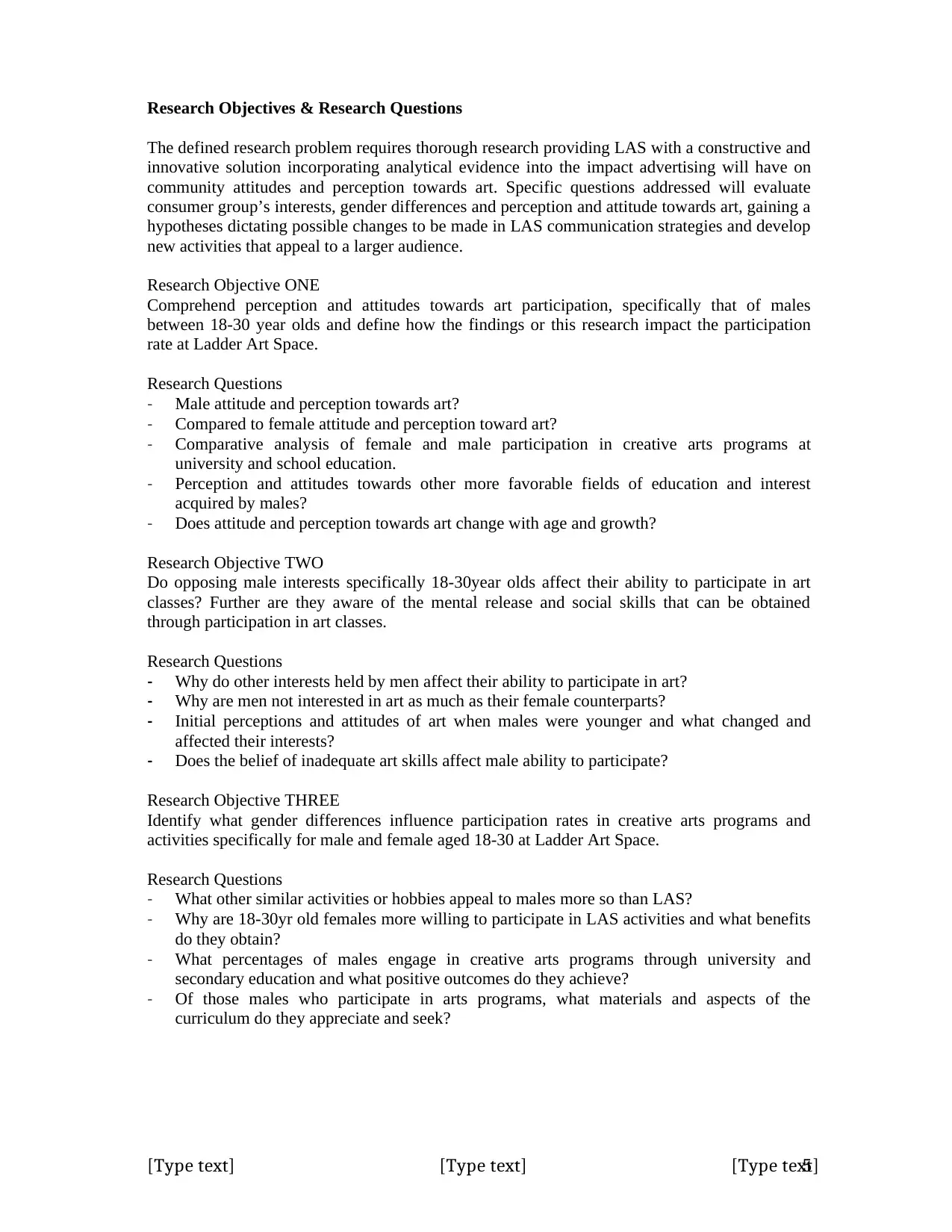
Research Objectives & Research Questions
The defined research problem requires thorough research providing LAS with a constructive and
innovative solution incorporating analytical evidence into the impact advertising will have on
community attitudes and perception towards art. Specific questions addressed will evaluate
consumer group’s interests, gender differences and perception and attitude towards art, gaining a
hypotheses dictating possible changes to be made in LAS communication strategies and develop
new activities that appeal to a larger audience.
Research Objective ONE
Comprehend perception and attitudes towards art participation, specifically that of males
between 18-30 year olds and define how the findings or this research impact the participation
rate at Ladder Art Space.
Research Questions
- Male attitude and perception towards art?
- Compared to female attitude and perception toward art?
- Comparative analysis of female and male participation in creative arts programs at
university and school education.
- Perception and attitudes towards other more favorable fields of education and interest
acquired by males?
- Does attitude and perception towards art change with age and growth?
Research Objective TWO
Do opposing male interests specifically 18-30year olds affect their ability to participate in art
classes? Further are they aware of the mental release and social skills that can be obtained
through participation in art classes.
Research Questions
- Why do other interests held by men affect their ability to participate in art?
- Why are men not interested in art as much as their female counterparts?
- Initial perceptions and attitudes of art when males were younger and what changed and
affected their interests?
- Does the belief of inadequate art skills affect male ability to participate?
Research Objective THREE
Identify what gender differences influence participation rates in creative arts programs and
activities specifically for male and female aged 18-30 at Ladder Art Space.
Research Questions
- What other similar activities or hobbies appeal to males more so than LAS?
- Why are 18-30yr old females more willing to participate in LAS activities and what benefits
do they obtain?
- What percentages of males engage in creative arts programs through university and
secondary education and what positive outcomes do they achieve?
- Of those males who participate in arts programs, what materials and aspects of the
curriculum do they appreciate and seek?
[Type text] [Type text] [Type text]5
The defined research problem requires thorough research providing LAS with a constructive and
innovative solution incorporating analytical evidence into the impact advertising will have on
community attitudes and perception towards art. Specific questions addressed will evaluate
consumer group’s interests, gender differences and perception and attitude towards art, gaining a
hypotheses dictating possible changes to be made in LAS communication strategies and develop
new activities that appeal to a larger audience.
Research Objective ONE
Comprehend perception and attitudes towards art participation, specifically that of males
between 18-30 year olds and define how the findings or this research impact the participation
rate at Ladder Art Space.
Research Questions
- Male attitude and perception towards art?
- Compared to female attitude and perception toward art?
- Comparative analysis of female and male participation in creative arts programs at
university and school education.
- Perception and attitudes towards other more favorable fields of education and interest
acquired by males?
- Does attitude and perception towards art change with age and growth?
Research Objective TWO
Do opposing male interests specifically 18-30year olds affect their ability to participate in art
classes? Further are they aware of the mental release and social skills that can be obtained
through participation in art classes.
Research Questions
- Why do other interests held by men affect their ability to participate in art?
- Why are men not interested in art as much as their female counterparts?
- Initial perceptions and attitudes of art when males were younger and what changed and
affected their interests?
- Does the belief of inadequate art skills affect male ability to participate?
Research Objective THREE
Identify what gender differences influence participation rates in creative arts programs and
activities specifically for male and female aged 18-30 at Ladder Art Space.
Research Questions
- What other similar activities or hobbies appeal to males more so than LAS?
- Why are 18-30yr old females more willing to participate in LAS activities and what benefits
do they obtain?
- What percentages of males engage in creative arts programs through university and
secondary education and what positive outcomes do they achieve?
- Of those males who participate in arts programs, what materials and aspects of the
curriculum do they appreciate and seek?
[Type text] [Type text] [Type text]5
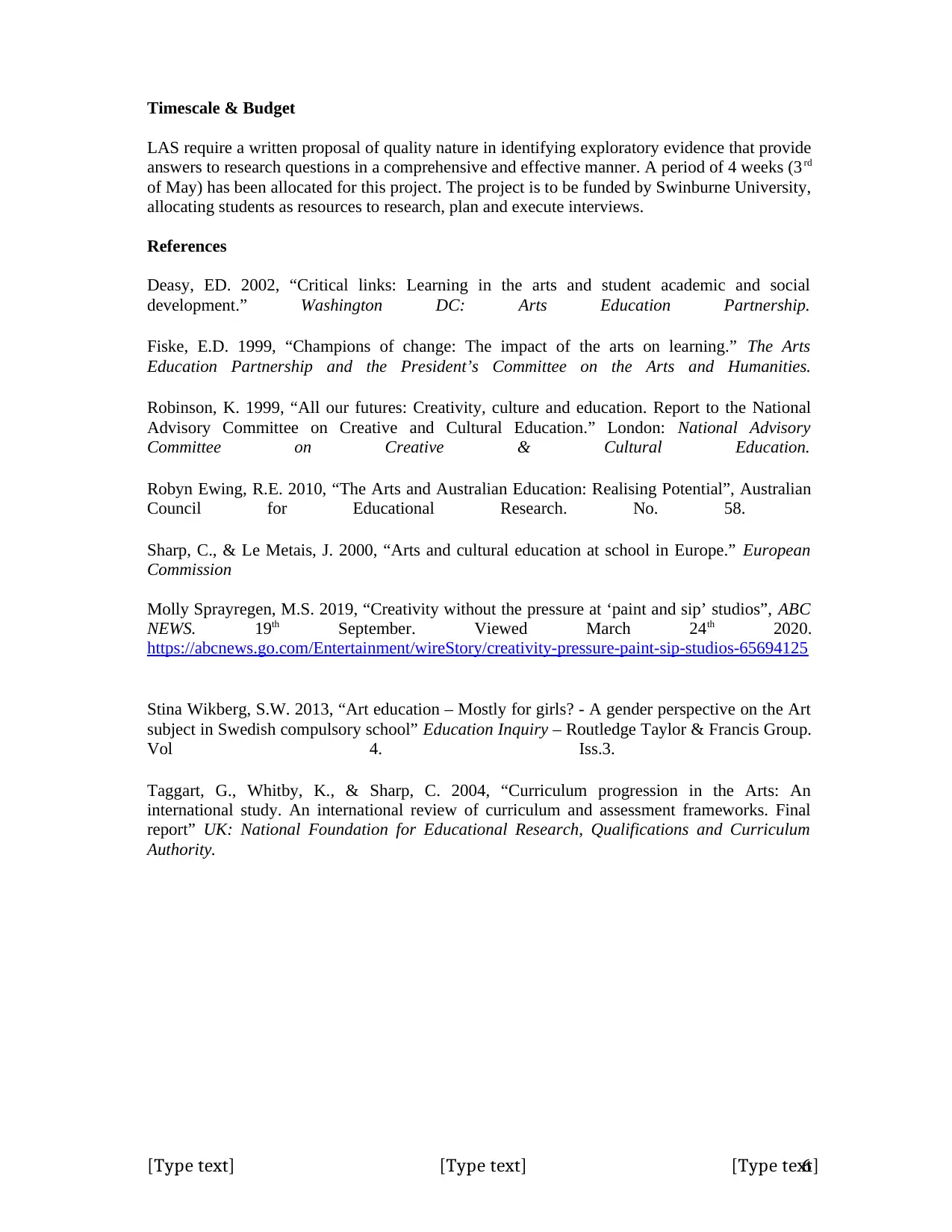
Timescale & Budget
LAS require a written proposal of quality nature in identifying exploratory evidence that provide
answers to research questions in a comprehensive and effective manner. A period of 4 weeks (3 rd
of May) has been allocated for this project. The project is to be funded by Swinburne University,
allocating students as resources to research, plan and execute interviews.
References
Deasy, ED. 2002, “Critical links: Learning in the arts and student academic and social
development.” Washington DC: Arts Education Partnership.
Fiske, E.D. 1999, “Champions of change: The impact of the arts on learning.” The Arts
Education Partnership and the President’s Committee on the Arts and Humanities.
Robinson, K. 1999, “All our futures: Creativity, culture and education. Report to the National
Advisory Committee on Creative and Cultural Education.” London: National Advisory
Committee on Creative & Cultural Education.
Robyn Ewing, R.E. 2010, “The Arts and Australian Education: Realising Potential”, Australian
Council for Educational Research. No. 58.
Sharp, C., & Le Metais, J. 2000, “Arts and cultural education at school in Europe.” European
Commission
Molly Sprayregen, M.S. 2019, “Creativity without the pressure at ‘paint and sip’ studios”, ABC
NEWS. 19th September. Viewed March 24th 2020.
https://abcnews.go.com/Entertainment/wireStory/creativity-pressure-paint-sip-studios-65694125
Stina Wikberg, S.W. 2013, “Art education – Mostly for girls? - A gender perspective on the Art
subject in Swedish compulsory school” Education Inquiry – Routledge Taylor & Francis Group.
Vol 4. Iss.3.
Taggart, G., Whitby, K., & Sharp, C. 2004, “Curriculum progression in the Arts: An
international study. An international review of curriculum and assessment frameworks. Final
report” UK: National Foundation for Educational Research, Qualifications and Curriculum
Authority.
[Type text] [Type text] [Type text]6
LAS require a written proposal of quality nature in identifying exploratory evidence that provide
answers to research questions in a comprehensive and effective manner. A period of 4 weeks (3 rd
of May) has been allocated for this project. The project is to be funded by Swinburne University,
allocating students as resources to research, plan and execute interviews.
References
Deasy, ED. 2002, “Critical links: Learning in the arts and student academic and social
development.” Washington DC: Arts Education Partnership.
Fiske, E.D. 1999, “Champions of change: The impact of the arts on learning.” The Arts
Education Partnership and the President’s Committee on the Arts and Humanities.
Robinson, K. 1999, “All our futures: Creativity, culture and education. Report to the National
Advisory Committee on Creative and Cultural Education.” London: National Advisory
Committee on Creative & Cultural Education.
Robyn Ewing, R.E. 2010, “The Arts and Australian Education: Realising Potential”, Australian
Council for Educational Research. No. 58.
Sharp, C., & Le Metais, J. 2000, “Arts and cultural education at school in Europe.” European
Commission
Molly Sprayregen, M.S. 2019, “Creativity without the pressure at ‘paint and sip’ studios”, ABC
NEWS. 19th September. Viewed March 24th 2020.
https://abcnews.go.com/Entertainment/wireStory/creativity-pressure-paint-sip-studios-65694125
Stina Wikberg, S.W. 2013, “Art education – Mostly for girls? - A gender perspective on the Art
subject in Swedish compulsory school” Education Inquiry – Routledge Taylor & Francis Group.
Vol 4. Iss.3.
Taggart, G., Whitby, K., & Sharp, C. 2004, “Curriculum progression in the Arts: An
international study. An international review of curriculum and assessment frameworks. Final
report” UK: National Foundation for Educational Research, Qualifications and Curriculum
Authority.
[Type text] [Type text] [Type text]6
⊘ This is a preview!⊘
Do you want full access?
Subscribe today to unlock all pages.

Trusted by 1+ million students worldwide
1 out of 6
Your All-in-One AI-Powered Toolkit for Academic Success.
+13062052269
info@desklib.com
Available 24*7 on WhatsApp / Email
![[object Object]](/_next/static/media/star-bottom.7253800d.svg)
Unlock your academic potential
Copyright © 2020–2025 A2Z Services. All Rights Reserved. Developed and managed by ZUCOL.
